
The AAF is folding before it even completed one full season after chairman and majority owner Tom Dundon pulled the plug on league operations Tuesday.
Once again, a startup football league has fallen on its face. Yet there were some bright spots during the eight weeks of action.
With that in mind, we’re looking at the biggest winners and losers from the AAF’s one and only season.
Winner: Trent Richardson, running back, Birmingham Iron
Richardson is a former first-round NFL bust who was thought to be completely done with football. Then he signed on with the AAF and proved he can still make an impact. In just eight games, he rushed in 11 touchdowns, a couple of rushing two-point conversions, added a receiving touchdown and two more receiving two-point conversions. Though his average per carry was a paltry 2.9 yards, he also showed burst in the passing game and tallied 205 yards on 31 receptions.
Loser: Tom Dundon, majority owner
Back in February, Carolina Hurricanes owner Tom Dundon propped up the AAF with a stunning $250 million investment. At the time, the league insisted that the money wasn’t a bailout, yet in hindsight that seems to have been untrue. Reportedly, Dundon lost $70 million on the deal before pulling the plug. Ouch.
Winner: Garrett Gilbert, quarterback, Orlando Apollos
Leading the most explosive offense in the AAF, Gilbert made the most of his opportunity. One of the best players on a weekly basis, he rarely made mistakes. Gilbert led the league in passing yards, averaging 269 yards per game, and threw 13 touchdowns (second-most in the league) while tossing just three interceptions. That kind of efficient production will get him a camp invite from an NFL team this summer.
Loser: Christian Hackenberg, quarterback, Memphis Express
After failing miserably at the NFL level for three seasons, Hackenberg tried his hand against lesser competition in the AAF. The former second-round pick continued to show that he just isn’t a professional-caliber quarterback. Before being replaced, Hackenberg completed just 51.6 percent of his passes for 277 yards with no touchdowns and three interceptions (including this miserable throw). If he couldn’t cut it at this level, it’s hard to imagine he can cut it anywhere.
Winner: Charles Johnson, wide receiver, Orlando Apollos
On the opposite end of the spectrum, Johnson proved he’s still worthy of NFL consideration after a tremendous stint in the AAF. Leading the league in receiving by a large margin, Johnson caught 45 passes for 687 yards and five touchdowns. He also led the AAF in targets with 70, proving to be a dynamic weapon for the Apollos from the start of the year until its conclusion.
Loser: Mike Singletary, head coach, Memphis Express
Once an NFL head coach, Singletary signed on with the AAF to help get his career back on track. Instead, he led the Express to the worst record in the league (tied with Atlanta). A defensive-minded head coach, Singletary failed to implement a disciplined unit on that side of the ball as Memphis gave up 194 points, which was also second-worst in the AAF. One of the greatest linebackers to ever play, Singletary seems out of his depth when it comes to tackling the head-coaching position.
Winner: Karter Schult, defensive end, Salt Lake Stallions
A former undrafted free agent who has nary a single NFL stat to his credit, Schult emerged this winter as one of the most dominant pass rushers in the AAF. A regular on our list of standout performers, he racked up seven sacks and 21 quarterback hits, both of which tied for second in the league. The 6-foot-3, 260-pounder should absolutely get another shot at playing in the NFL after what he did in the AAF.
Loser: Bill Polian and Charlie Ebersol, co-founders
On the surface, what Polian and Ebersol tried to do was fantastic. They envisioned a league that could act as a filter and training ground for young players who needed reps and seasoning before starring in the NFL. Yet all their efforts to become associated with the NFL were rejected. And in the end, their vision was shut down by Dundon, despite their wishes to keep the league going.
Winner: Steve Spurrier, head coach, Orlando Apollos
The old ball coach can still bring it. Spurrier’s Apollos were far and away the best team in the AAF. They led the league in scoring (29.5 points per game), and in defensive scoring (allowing just 17 points per game). If the league had been allowed to finish its inaugural season, it stands to reason Orlando would have claimed the title. And on top of the good football Spurrier’s team produced, the coach showed he’s still got it in the zinger department, too.